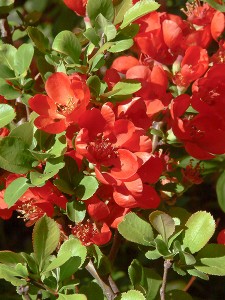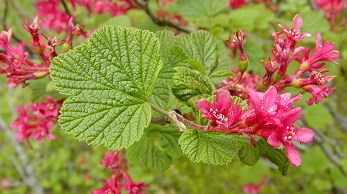Submitted by Mary Jo Buza
 The last days of winter were unusually nice. So warm it felt like summer and the plants are loving it! Many plants are blooming early, confirming that spring has arrived. For example, Osoberry a native shrub, is blooming now.
The last days of winter were unusually nice. So warm it felt like summer and the plants are loving it! Many plants are blooming early, confirming that spring has arrived. For example, Osoberry a native shrub, is blooming now.
Osoberry is a large shrub that grows along the rivers, streams and lakes. It is a very common shrub that you may notice even growing along roadsides. Osoberry is the first native shrub to bloom each year and its small white flowers are always welcome.
After the Osoberry, red flowering currant is the next native plant to bloom, but this year they are blooming at the same time. Red flowering currant is an important source of nectar for the hummingbirds. It appears that hummingbirds synchronize their schedules with the appearance of the red flowering currant and quince flowers. Is it possible that the hummingbirds time their arrival to coincide with the blooming cycle of this native shrub? I rarely notice the hummingbirds until the red flowering currants begin to bloom.
Very adaptable, red flowering currant tolerates a variety of soils including heavy clay. It blooms prolifically when planted in a sunny location, but it also tolerates light shade. The striking raspberry-red flowers attract lots of attention in any garden. Most nurseries sell out of this native shrub each year. If you want to plant one in your garden this spring, be sure to buy one soon before they sell out. Nurseries also sell a white flowering currant called ‘Icicle’ that is also popular, but I am not sure it will attract hummingbirds. Red and white flowering currants are large shrubs growing quickly to 8 feet tall and wide. Deer love red flowering currant.
 Another early blooming shrub is flowering quince. Not a native plant, but a favorite of hummingbirds. Flowering quince blooms for up to three weeks. Flowering quince is an ‘old fashion’ plant. You are more likely to find it growing in your grandmother’s gardens rather than our own garden. Many varieties of quince are large, growing ten to twelve feet tall and wide. However, smaller compact varieties are now available. Flowers vary in color from red to reddish orange to salmon.
Another early blooming shrub is flowering quince. Not a native plant, but a favorite of hummingbirds. Flowering quince blooms for up to three weeks. Flowering quince is an ‘old fashion’ plant. You are more likely to find it growing in your grandmother’s gardens rather than our own garden. Many varieties of quince are large, growing ten to twelve feet tall and wide. However, smaller compact varieties are now available. Flowers vary in color from red to reddish orange to salmon.
If you are like me and crave shrubs that bloom early to reassure you that spring is still on schedule, add red flowering currant and quince to your garden. Other early blooming plants include camellia, forsythia, winterhazel, Oregon grape, hellebore and the wonderfully fragrant evergreen clematis- a vine.
Author Mary Jo Buza, is a landscape designer. She has over 20 years experience maintaining, designing, and teaching gardening in the South Sound region. For more information on a custom landscape design or consultation call 923-1733 or www.maryjobuza.com.
Photos used with permission of the Washington Native Plant Society.




















































